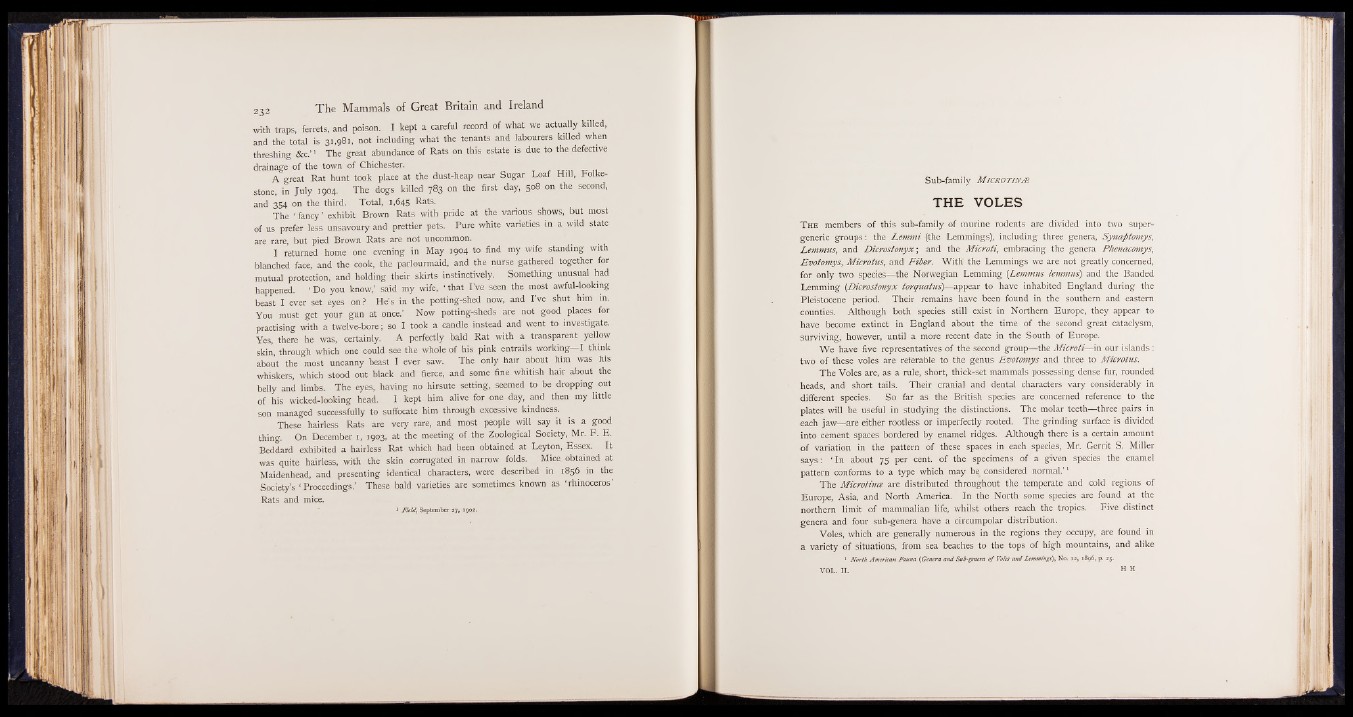
with traps, ferrets, and poison. I kept a careful record of what we actually killed,
and the total is 31,981, not including what the tenants and labourers killed when
threshing &c.’ 1 The great abundance of Rats on this estate is due to the defective
drainage of the town of Chichester.
A great Rat hunt took place at the dust-heap near Sugar Loaf Hill, Folke-
stone, in July 1904. The dogs killed 783 on the first day, 508 on the second,
and 354 on the third. Total, 1,645 R^s*
The ‘ fancy’ exhibit Brown Rats with pride at the various shows, but most
of us prefer less unsavoury and prettier pets. Pure white varieties in a wild state
are rare, but pied Brown Rats are not uncommon.
I returned home one evening in May 1904 to find my wife standing with
blanched face, and the cook, the parlourmaid, and the nurse gathered together for
mutual protection, and holding their skirts instinctively. Something unusual had
happened. ‘ Do you know,' said my wife, ‘ that I ’ve seen the most awful-looking
beast I ever set eyes on? He's in the potting-shed npw, and I've shut him in.
You must get your gun at once.’ Now potting-sheds are not good places for
practising with a twelve-bore ; so I took a candle instead and went to investigate.
Yes, there he was, certainly. A perfectly bald Rat with a transparent yellow
skin, through which one could see the whole of his pink entrails working—I think
about the most uncanny beast I ever saw. The only hair about him was his
whiskers, which stood out black and fierce, and some fine whitish hair about the
belly and limbs. The eyes, having no hirsute setting, seemed to be dropping out
of his wicked-looking head. I kept-him alive for one day, and then my littlg
son managed successfully to .Suffocate him through excessive kindness.
These hairless Rats are very rare, and most people will say it is a good
thing. On December 1, 1903, at the meeting of the Zoological Society, Mr. F . E.
Beddard exhibited a hairless Rat which had been obtained at Leyton, Essex. It
was quite hairless, with the skin corrugated in narrow folds. Migobtained at
Maidenhead, and presenting identical characters, were described in 1856 in the
Society's ‘ Proceedings.’ These bald varieties are sometimes known as ‘ rhinoceros’
Rats and mice.
1 Field, September 27, 1902.
Sub-family MICROTINÆ
THE VOLES
T h e members of this sub-family of murine rodents are divided into two supergeneric
groups: the Lem m i (the Lemmings), including three genera, Synafitomys,
Lemmus, and D icrostonyx; and the M icroti, embracing the genera Phenacomys,
Evotomys, Microtus, and F ib er. With the Lemmings we are not greatly concerned,
for only two species—the Norwegian Lemming (Lemmus lemmus) and the Banded
Lemming (Dicrostonyx torquatus)—appear to have inhabited England during the
Pleistocene period. Their remains have been found in the southern and eastern
counties. Although both species still exist in Northern Europe, they appear to
have become extinct in England about the time of the second great cataclysm,
surviving, however, until a more recent date in the South of Europe.
We have five representatives of the second group—the M icroti—in our islands :
two of these voles are referable to the genus Evotomys and three to Microtus.
The Voles are, as a rule, short, thick-set mammals possessing dense fur, rounded
heads, and short tails. Their cranial and dental characters vary considerably in
different species. So far as the British species are concerned reference to the
plates will be useful in studying the distinctions. The molar teeth—three pairs in
each jaw—are either rootless or imperfectly rooted. The grinding surface is divided
into cement spaces bordered by enamel ridges. Although there is a certain amount
of variation in the pattern of these spaces in each species, Mr. Gerrit S. Miller
says: ‘ In about 75 per cent, of the specimens of a given species the enamel
pattern conforms to a type which may b^ considered normal.’ 1
The Microtince are distributed throughout the temperate and cold regions of
Europe, Asia, and North America. In the North some species are found at the
northern limit of mammalian life, whilst others reach the tropics. Five distinct
genera and four sub-genera have a circumpolar distribution.
Voles, which are generally numerous in the regions they occupy, are found in
a variety of situations, from sea beaches to the tops of high mountains, and alike
1 North American Fauna (Genera and Sub-genera o f Voles and Lemmings), No. 12, 1896, p. 25.
VOL. II. H H